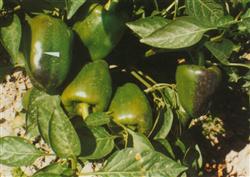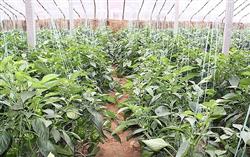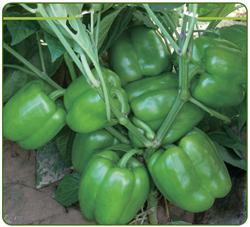What are the common physiological diseases of sweet pepper?

What are the common physiological diseases of sweet pepper? Please introduce the common physiological diseases of sweet pepper: first, sunburn disease 1. Symptoms. The cause of the disease is bright light, and the symptoms only appear on the sunny side of the fruit. In the early stage of the disease, the disease faded, slightly wrinkled, grayish white or yellowish. The pulp of the diseased part is thinner, nearly leathery, translucent, tissue necrosis is hard and taut, easy to rupture. In the later stage, the disease was infected by bacteria or saprophytic fungi, with black, gray, pink or mixed mildew layer, and the diseased fruit was easy to rot. two。 The cause. Sunburn disease is mainly caused by sunlight burning fruit epidermis cells, resulting in water metabolism disorders. Soil lack of water, excessive dry and hot weather, sunny after rain, heavy soil viscosity, low-lying water and so on can be caused. In the fields where the virus disease is more serious, excessive sparse planting and so on, the sunburn disease is particularly serious. Calcitonin plays an important role in water metabolism of sweet pepper. Physiological factors such as large leaching loss of calcium in soil, excessive application of nitrogen and disturbance of calcium absorption are also related to the occurrence of sunburn. 3. Control methods ⑴ reasonable close planting and intercropping. Double-row close planting with large ridges can shade the plants from each other and avoid direct light. Rational irrigation of ⑵. Results after the peak period, small water should be watered frequently, watering in the morning and avoiding watering in the afternoon. In particular, clayey soil should prevent too much watering from causing anoxic drought. ⑶ was fertilized outside the root. 0.1% calcium nitrate solution was sprayed after fruit setting, once every 10 days or so, for 2 or 3 times. ⑷ uses sunshade nets. Black shading net can be used to reduce the glare. Second, sweet pepper cultivated in open field and greenhouse often occurs pedicle rotten fruit in the process of growth and development. Sweet pepper pedicel rotten fruit is the same as tomato pedicle rotten fruit, which is caused by calcium deficiency. High temperature, dryness, fertilizer, potassium and other conditions will inhibit the absorption of calcium and produce pedicel rotten fruit. Plant growth can absorb sufficient calcium, but the plant vegetative growth is too prosperous, calcium is allocated to leaf buds, fruit is only distributed to a small amount of calcium, in this case will also produce pedicle rot. Prevention and control methods: the soil should be suitable for the development of root system, take root deeply and absorb calcium well. Apply more organic fertilizer to make calcium in a state that can be easily absorbed. Third, sweet pepper cultivated in stone fruit greenhouse, short style unisexual fruiting to produce stone fruit. The fruit with few seeds has less distribution of assimilation nutrients and forms stone fruit. Persistent stone fruit on the plant will weaken the plant growth. For normal flowers with long style flowers, when the temperature is too low, the anther can not open and can not be fertilized, which will produce stone fruit, so the night temperature must be kept above 15 ℃. To reduce the occurrence of stone fruit, it is necessary to have well-developed flower buds to make good fertilization, and to strengthen field management so that plants can carry out exuberant assimilation, and greenhouse cultivation in winter and spring should pay attention to heat preservation. 4. Fallen leaves, flowers and fruits. Symptoms. Sweet pepper defoliation, flower and fruit drop, also known as "three falling disease", is an important problem in protected and open field production. In the early stage, some buds fall off, some fall flowers, some fall buds or flowers after the connection between fruit stalks and buds become ferruginous, some pedicels turn yellow and fall off one by one, and some fall leaves in the middle and later stages of production, resulting in serious losses in production. two。 The cause. The choice of variety is not the right way. In off-season cultivation, the temperature was not satisfied during the growth period of sweet pepper, and the physiological function of the root system decreased when the soil temperature was lower than 18 ℃. When the root system stopped growing at 8 ℃, it was easy to shed leaves and flowers, and when the temperature was below 15 ℃, it could blossom, but the anther could not release powder, which could easily lead to flower drop. During the growth period, when there is a long period of continuous overcast weather, insufficient light or relative humidity less than 70%, overnutrition or imbalance between vegetative growth and reproductive growth, excessive plant growth, insufficient or excessive water can lead to flower drop, bud drop or fruit drop. The soil fertility is insufficient, the management can not keep up, the vegetable seedlings can not grow slowly and quickly after planting, and the branches and leaves can not seal ridges in the high temperature season, resulting in the rise of ground temperature, which is easy to cause unfruitful flowering, or falling flowers and buds. Diseases and insect pests. The application of unrotten organic fertilizer, especially unfermented chicken manure, will cause root burning or retting, so that water and nutrients can not be supplied normally, and it will also cause "three falls". 3. ⑴ control methods according to local conditions, select local varieties that are resistant to low temperature, weak light or early maturity. ⑵ scientifically determined the suitable sowing date to meet the needs of 20 ℃ ~ 30 ℃ for sweet pepper and 25 ℃ for ground temperature. It is necessary to consider not only whether the greenhouse temperature meets the requirements, but also whether the ground temperature can reach more than 18 ℃ and whether it can be harmed by excessive high temperature in the growing season. Especially when the ground temperature is more prominent, to prevent futile growth or decay for not long. ⑶ should pay attention to the prevention and control of scab, anthracnose, virus, tobacco green worm, tea yellow mite and other diseases and pests. ⑷ is cultivated with plastic film mulching, which can break the film in the high temperature season to prevent the soil temperature from being too high, and can be covered with sunshade net if possible. ⑸ applied fertilizer for promoting seedling, attacking fruit and returning seedling according to plant growth, adopted formula fertilization technology to prevent de-fertilizing in the later growth stage, and applied liquid fertilizer or plant growth regulator on leaf surface to supplement nutrition. Click to get more sweet pepper planting techniques click to get more vegetable planting techniques
- Prev

How to fertilize sweet pepper can increase production?
How to fertilize sweet pepper can increase production? Please introduce the fertilization method of sweet pepper with long growing period, underdeveloped root system, few roots, shallow soil penetration, drought tolerance and waterlogging tolerance. It needs more fertilizer than tomato and eggplant, and has strong fertilizer tolerance. The fertilizer requirement of sweet pepper was the highest in potassium absorption, the second in nitrogen and the lowest in phosphorus. Sweet peppers in vegetables.
- Next

How to manage sweet pepper before picking?
How to manage sweet pepper before picking? Please introduce the vegetable farmers who grow sweet peppers know that the second crop of sweet peppers is particularly important in the whole growth period management, because this period is the key period to determine the level of income. At present, most of the first crop of sweet pepper has been picked, how to ensure the yield and quality of the second crop? The reporter admitted that.
Related
- Where is it suitable to grow horseradish in China? it is expected to see the middle altitude horseradish in Alishan.
- How to prevent tomato virus disease reasonably? (Control methods included)
- Many people like to plant towel gourd on the balcony. What are the main points of this method and management?
- What crops can chili peppers be mixed with?
- Fertilization techniques and matters needing attention in Tomato
- What are the grafting techniques for peach seedlings in spring?
- Harm and control methods of root swelling disease of Chinese cabbage
- What are the pests of sweet potatoes? How to prevent and cure it?
- Symptoms, causes and Control methods of navel Rot in Tomato
- The cause of "Cucumber rotten bibcock" in Farmers' planting Cucumber and its Control Plan

